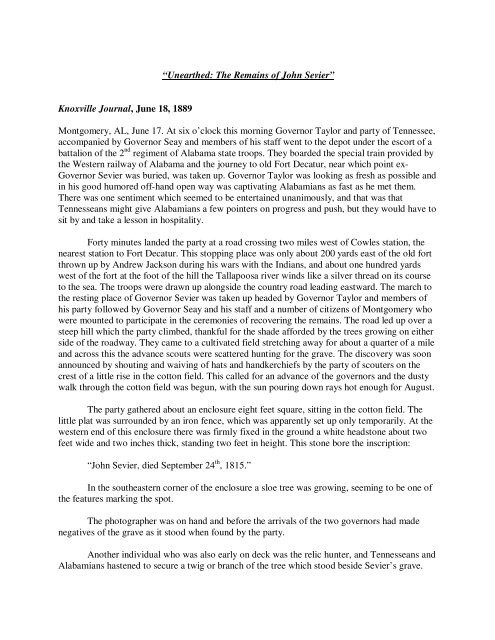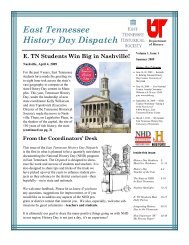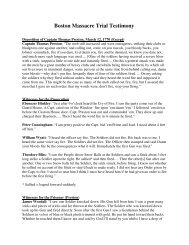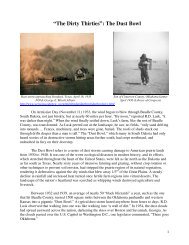John Sevier - Teach American History
John Sevier - Teach American History
John Sevier - Teach American History
Create successful ePaper yourself
Turn your PDF publications into a flip-book with our unique Google optimized e-Paper software.
Knoxville Journal, June 18, 1889<br />
“Unearthed: The Remains of <strong>John</strong> <strong>Sevier</strong>”<br />
Montgomery, AL, June 17. At six o’clock this morning Governor Taylor and party of Tennessee,<br />
accompanied by Governor Seay and members of his staff went to the depot under the escort of a<br />
battalion of the 2 nd regiment of Alabama state troops. They boarded the special train provided by<br />
the Western railway of Alabama and the journey to old Fort Decatur, near which point ex-<br />
Governor <strong>Sevier</strong> was buried, was taken up. Governor Taylor was looking as fresh as possible and<br />
in his good humored off-hand open way was captivating Alabamians as fast as he met them.<br />
There was one sentiment which seemed to be entertained unanimously, and that was that<br />
Tennesseans might give Alabamians a few pointers on progress and push, but they would have to<br />
sit by and take a lesson in hospitality.<br />
Forty minutes landed the party at a road crossing two miles west of Cowles station, the<br />
nearest station to Fort Decatur. This stopping place was only about 200 yards east of the old fort<br />
thrown up by Andrew Jackson during his wars with the Indians, and about one hundred yards<br />
west of the fort at the foot of the hill the Tallapoosa river winds like a silver thread on its course<br />
to the sea. The troops were drawn up alongside the country road leading eastward. The march to<br />
the resting place of Governor <strong>Sevier</strong> was taken up headed by Governor Taylor and members of<br />
his party followed by Governor Seay and his staff and a number of citizens of Montgomery who<br />
were mounted to participate in the ceremonies of recovering the remains. The road led up over a<br />
steep hill which the party climbed, thankful for the shade afforded by the trees growing on either<br />
side of the roadway. They came to a cultivated field stretching away for about a quarter of a mile<br />
and across this the advance scouts were scattered hunting for the grave. The discovery was soon<br />
announced by shouting and waiving of hats and handkerchiefs by the party of scouters on the<br />
crest of a little rise in the cotton field. This called for an advance of the governors and the dusty<br />
walk through the cotton field was begun, with the sun pouring down rays hot enough for August.<br />
The party gathered about an enclosure eight feet square, sitting in the cotton field. The<br />
little plat was surrounded by an iron fence, which was apparently set up only temporarily. At the<br />
western end of this enclosure there was firmly fixed in the ground a white headstone about two<br />
feet wide and two inches thick, standing two feet in height. This stone bore the inscription:<br />
“<strong>John</strong> <strong>Sevier</strong>, died September 24 th , 1815.”<br />
In the southeastern corner of the enclosure a sloe tree was growing, seeming to be one of<br />
the features marking the spot.<br />
The photographer was on hand and before the arrivals of the two governors had made<br />
negatives of the grave as it stood when found by the party.<br />
Another individual who was also early on deck was the relic hunter, and Tennesseans and<br />
Alabamians hastened to secure a twig or branch of the tree which stood beside <strong>Sevier</strong>’s grave.






